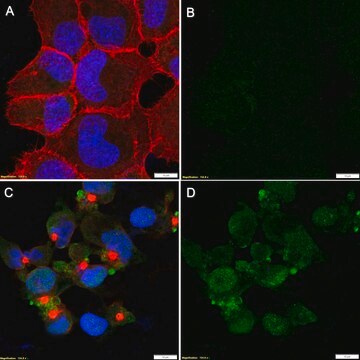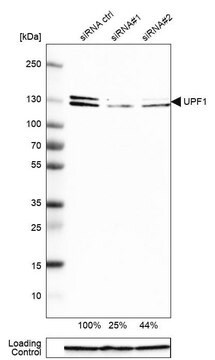07-1016
Anti-phospho-Upf1 (Ser1127) Antibody
from rabbit, purified by affinity chromatography
동의어(들):
Regulator of nonsense transcripts 1, ATP-dependent helicase RENT1, Nonsense mRNA reducing factor 1, NORF1, Up-frameshift suppressor 1 homolog, hUpf1
About This Item
추천 제품
생물학적 소스
rabbit
Quality Level
항체 형태
affinity isolated antibody
항체 생산 유형
primary antibodies
클론
polyclonal
정제법
affinity chromatography
종 반응성
mouse, human
종 반응성(상동성에 의해 예측)
chicken (based on 100% sequence homology), zebrafish (based on 100% sequence homology), yeast (based on 100% sequence homology), bovine (based on 100% sequence homology), rat (based on 100% sequence homology)
기술
immunoprecipitation (IP): suitable
western blot: suitable
NCBI 수납 번호
UniProt 수납 번호
배송 상태
wet ice
타겟 번역 후 변형
phosphorylation (pSer1127)
유전자 정보
human ... UPF1(5976)
일반 설명
특이성
면역원
애플리케이션
Peptide Inhibition Analysis: A 1:1,000 dilution from a representative lot blocked phospho-Upf1 (Ser1127) in NIH3T3 treated with Calyculin A and Okadaic Acid.
Immunoprecipitation Analysis: 5 µg from a representative lot immunoprecipitated phospho-Upf1 (Ser1127) in NIH3T3 treated with Calyculin A and Okadaic Acid.
품질
Western Blotting Analysis: A 1:1,000 dilution of this antibody detected phospho-Upf1 (Ser1127) in 10 µg lysate from NIH3T3 treated with Calyculin A (50 nM) and Okadaic Acid (500 nM) for 30 minutes.
표적 설명
기타 정보
적합한 제품을 찾을 수 없으신가요?
당사의 제품 선택기 도구.을(를) 시도해 보세요.
Storage Class Code
12 - Non Combustible Liquids
WGK
WGK 1
Flash Point (°F)
Not applicable
Flash Point (°C)
Not applicable
시험 성적서(COA)
제품의 로트/배치 번호를 입력하여 시험 성적서(COA)을 검색하십시오. 로트 및 배치 번호는 제품 라벨에 있는 ‘로트’ 또는 ‘배치’라는 용어 뒤에서 찾을 수 있습니다.
자사의 과학자팀은 생명 과학, 재료 과학, 화학 합성, 크로마토그래피, 분석 및 기타 많은 영역을 포함한 모든 과학 분야에 경험이 있습니다..
고객지원팀으로 연락바랍니다.







